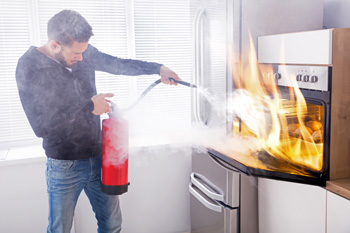Fire Extinguishers
- Get Prepared
- Fire Safety
- Current: Fire Extinguishers
In 2023, fires caused almost $23 billion in property damage. Fire extinguishers, when used properly, can save lives and significantly reduce property damage. While all types of fire extinguishers are effective fire safety tools, they should only be used if a fire is contained to a single object and not spreading.
Fire Extinguisher Safety Tips
Quick Tips
- Have fire extinguishers available for the types of fires that may occur at your location.
- Store fire extinguishers next to exits to ensure the fire is not blocking a safe escape if it spreads.
- Before using the fire extinguisher, make sure your path to evacuate is clear. If you cannot extinguish the fire, you will need to escape.

Types of Fire Extinguishers
There are five types of extinguishers designed to put out the different types of fire classes. Knowing the different fire classes will help you determine which types of fire extinguishers to have available for use.
The different fire classes are:
- Class A: Ordinary combustibles such as cloth, wood, rubber paper and many plastics
- Class B: Flammable liquids such as gasoline, oils, oil-based paint, alcohols, petroleum gases and tars
- Class C: Energized electric equipment such as appliances, tools and computers
- Class D: Combustible industrial metals such as sodium, lithium, titanium, magnesium and potassium
- Class K: Cooking oils and greases such as animal and vegetable fats

Using a Fire Extinguisher
After identifying the appropriate type of fire extinguisher to use, it is important to make sure you understand how to properly operate one. Become familiar with how to use a fire extinguisher before a fire occurs, and always remember to:
- Use a fire extinguisher only when the fire is contained to a single object and not spreading.
- Use a fire extinguisher that is large enough to put out a small fire, but not so heavy that it makes handling it difficult.
- Store fire extinguishers next to exits to ensure the fire is not blocking a safe escape if it spreads.
- Before using the fire extinguisher, make sure your path to evacuate is clear. If you cannot extinguish the fire, you will need to escape.
- Follow the word “PASS”:
- Pull the pin at the top of the extinguisher that keeps the handle from being accidentally pressed.
- Aim the nozzle toward the base of the fire, standing approximately eight feet away.
- Squeeze the handle slowly and evenly.
- Sweep the nozzle back and forth at the base of the fire.
